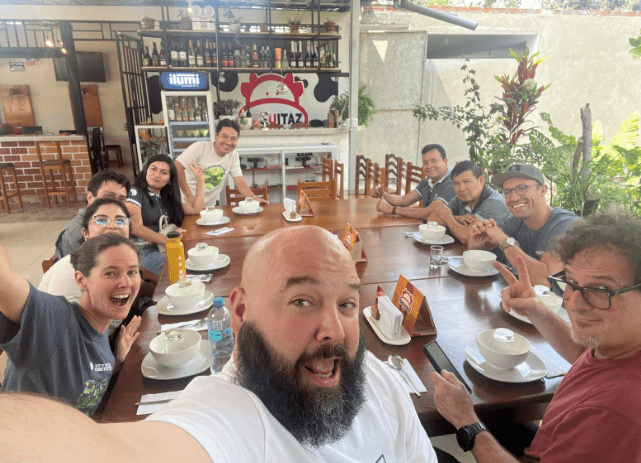
A Trip to Peru as a Coffee Roasting and Sourcing Manager
Last year, Roaster Nick Berardi and COO Scott traveled to Peru to visit Finca Churupampa, a coffee farm making waves in the coffee industry. Their trip wasn’t just about tasting exceptional coffee; it was an opportunity to dive deep into the work being done at origin. From exploring regenerative farming practices to discussing how the Tocto brothers are transforming their community, Nick shares his firsthand experience of what makes Finca Churupampa a truly special place in the coffee world.
Highlights
The highlight of my visit was undoubtedly the time spent with Eber and Talhya, the husband-and-wife duo leading Finca Churupampa. Their generosity in hosting us at their Jaén headquarters and farm was impressive, but what stood out even more was their commitment to collaboration. Despite being in the peak of the coffee season, they took a day off to join us for a six-and-a-half-hour drive to Chiclayo, where they engaged in conversations with other producers and industry leaders. Their interactions showcased a rare spirit of “coopetition” within the coffee industry—where cooperation meets competition in a way that benefits everyone involved.

Beyond logistics and operations, my personal peak was engaging in cupping sessions with Eber and his team. As a self-proclaimed coffee nerd, the opportunity to share insights and trade sensory experiences was incredibly fulfilling. More than just tasting coffee, it was about contributing feedback that could help fine-tune their processes. It wasn’t about playing the role of an outside expert swooping in with all the answers—it was about learning from each other and reinforcing the value of their work in real time.
Every Adventure Has its Challenges
Every adventure has its challenges, and this trip was no exception. The sheer ruggedness of origin travel took some adjusting. Scott and I were on the road for eight days, with the bookends of our trip essentially dedicated to transit: a 4:30 AM departure from the U.S., multiple flights to Peru, and an exhausting sequence of bumpy, mountainous truck rides totaling nearly 10 hours before finally arriving at our hotel late into the night.
I’ll admit, there were moments—especially during that first seven-hour ride where I kept hitting my head on the truck—when I questioned whether origin travel was for me. But as the trip progressed, I found my rhythm. The long drives became opportunities for deep conversations with our traveling companions, Stacy and Jeff, making the journey as enriching as the destination itself.
Beyond my personal struggles with travel, the most consistent challenge voiced by producers was climate change. While regenerative farming aligns with traditional Peruvian agricultural methods, farmers still grapple with the uncertainty of investing in regenerative certification. The real hurdle? Market demand. Many wondered if the premium certification would translate into a meaningful return. That’s where Utopian Coffee came in—being able to say, “We are committed to buying X number of Regenerative containers this year” helped reinforce that the market does exist and will support their efforts. This season, they produced 12 containers of regenerative coffee, and with growing interest from Utopian and other roasters, that number is set to increase in the coming years.
Regenerative Farming in Action
One of the most striking aspects of regenerative farming at Finca Churupampa is how intuitive it feels to the producers. Unlike some farming regions where organic and regenerative methods are seen as a shift from conventional practices, Peru’s coffee sector has long embraced a natural, resourceful approach. Before organic certification was even a concept, Peruvian farmers were already using local materials for fertilization—guano from island birds, composted guinea pig droppings, and agricultural byproducts.

At Finca Churupampa, they’ve taken these methods to the next level. They continuously refine their composting process, ensuring the right balance of materials to maximize nutrient retention. Their latest innovation? Pelletizing fertilizer. This not only allows for more precise application but also reduces nutrient runoff during heavy rains.

While it requires more labor, it’s a prime example of how regenerative practices replace chemicals with human effort—fostering a system where farmers have greater control over their soil health and long-term productivity.
What Makes Finca Churupampa Unique?
One of the most intriguing aspects of Finca Churupampa is that it’s essentially two entities: the family farm, which serves as an innovation hub, and the larger farming group consolidating 322 producers. The family farm, originally run by Eber’s father, is now used as a testing ground for new techniques before they’re implemented at scale. This dual structure allows for experimentation without risking the livelihood of their wider network.
Another standout feature is their team of technicos—agronomists who regularly visit farmers to troubleshoot challenges and refine best practices. It’s a hands-on, holistic approach that ensures each farmer has the support they need to succeed, reinforcing the cooperative nature of the Finca Churupampa model.
A Meaningful Connection
Scott and I approached this trip with a clear mission: to connect with regenerative leaning producer groups and work collaboratively toward a more sustainable coffee industry. While we certainly had moments of discovery trekking up and down mountains to meet individual farmers, the real impact came from our conversations with producer leaders. The goal wasn’t to find a hidden gem of a micro-lot—it was to support broader systems that benefit entire communities.
Leaving Finca Churupampa, I felt a renewed sense of purpose. The work being done here isn’t just about producing great coffee—it’s about creating a resilient, sustainable future for farmers. With each sip of this coffee, I’m reminded of the dedication, ingenuity, and perseverance that make it all possible.
Check out coffee from Finca Churupampa Here!

